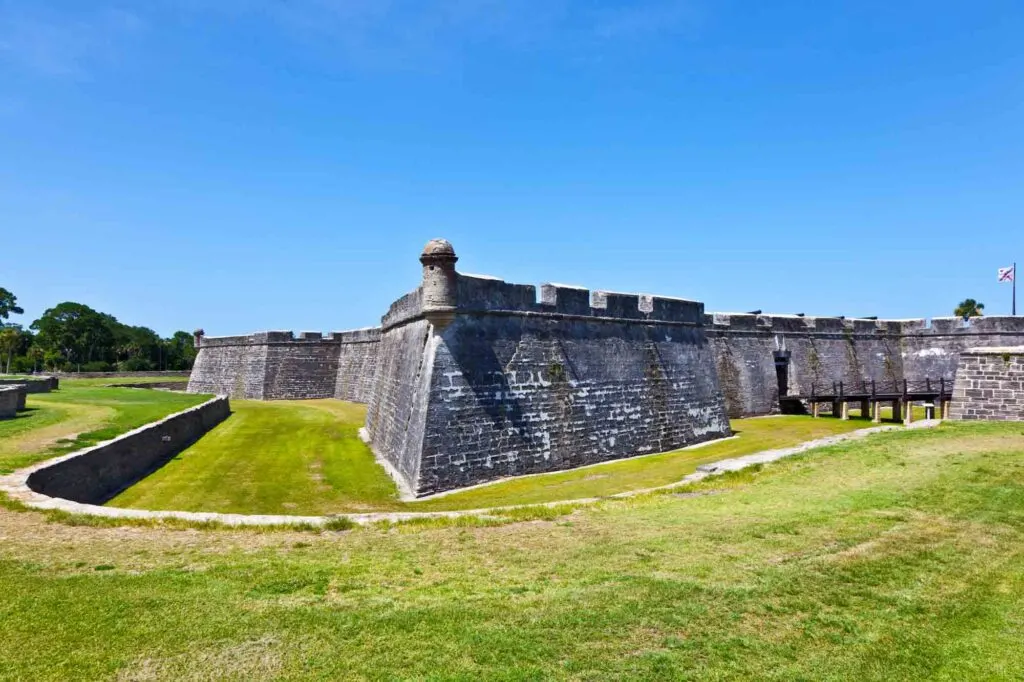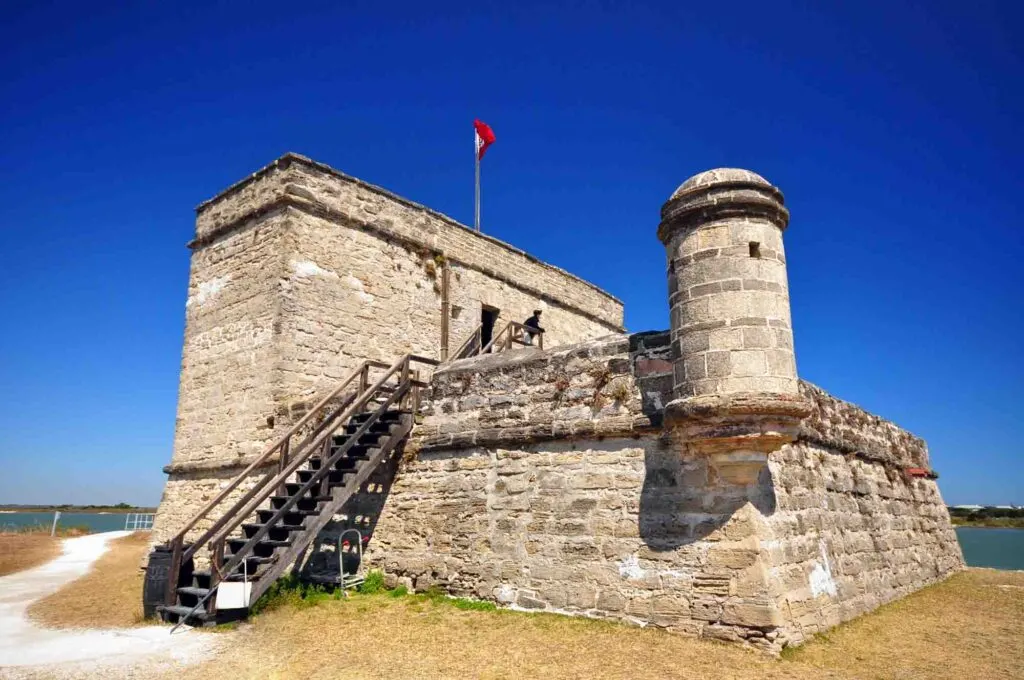- 26 Kentucky Facts: Fun Facts About Kentucky You Need To Know - November 3, 2023
- 26 Florida Facts: Fun Facts About Florida You Need to Know - October 20, 2023
- 26 North Carolina Facts: Fun Facts About North Carolina To Know - October 13, 2023
Have you ever wondered what the national parks in Florida are like?
Most of us know Florida as The Sunshine State. When we imagine vacationing (or retiring) down in Florida, we picture long, sunny days laid out on the beach.
And truthfully, that’s a pretty accurate depiction considering that there are 1,350 miles of coastline!
While it’s true that Florida has tons of gorgeous beaches, there is a lot more to it than that.
So, when looking at the national parks in Florida, you get a much more inclusive look into all of the different ecosystems found throughout the state.
There are definitely pristine beaches, but also forests, prairies, swamps, mangroves, and coral reefs that make up the beautiful, diverse nature of Florida. Plus, many of the parks are full of interesting history lessons too!
11 National Parks in Florida that You’ll Want to Explore
Here are the incredible Florida national parks in no particular order.
1. Everglades National Park

Spanning over 1.5 million acres, the Everglades National Park is one of the largest in the country. The protected area is the largest subtropical wilderness in the United States.
It not only provides protection for a wide variety of species and breathtaking landscapes to explore, but according to the National Wildlife Foundation, it also provides drinking water, protects from hurricanes, and supports the fishing industry.
The Everglades is one of the Florida national parks teeming with wildlife, and trying to catch a peek at some of the native species is one of the top things to do here.
Your chances of seeing alligators and many species of birds are pretty high, but keep your eyes open for crocodiles, turtles, deer, and snakes. If you’re really lucky, you might even see a manatee or Florida panther.
The park boasts plenty of options for biking, birdwatching, fishing, hiking, and boating. On top of that, there is wilderness camping in the Everglades backcountry people who are really adventurous.
Finally, for those who want to get up close and personal with the mangroves, the Wilderness Waterway is a 99-mile long trip done by kayak or canoe.
Visit Everglades National Park
- Address: 40001 State Road 9336, Homestead, Florida 33034
- Entrance fee: $30 per vehicle – alternatively, you can purchase the America the Beautiful Pass to save you money if you’re planning on visiting a few US national parks within 12 months.
Visit the National Park Service’s website for more practical info and directions.
Read next: Best Cabins in Florida
2. Biscayne National Park

Dubbed a “watery wonderland” by the National Park Service, Biscayne National Park is responsible for protecting some of the most important coral reefs in the United States that stretch between mainland Florida and the Keys.
Considering that 95% of this national park in Florida is water, the best way to explore is with a boat tour. There are also many water activities available for visitors, some of which may surprise you – like kiteboarding!
Fishing is one of the more common pastimes here, with plenty of spring lobster, snapper, grouper, tarpon, and bonefish populations.
Of course, where there’s plenty of fish, you’ll also find scuba divers! Both snorkeling and diving are available to explore the many reefs as well as multiple shipwrecks found here.
Despite being mostly water, there are a few campgrounds in Biscayne National Park you can enjoy.
Boca Chita Key and Elliot Key each offer camping areas that are accessible only by boat, giving you the ultimate remote island camping experience!
Visit Biscayne National Park
- Address: 9700 SW 328th Street, Sir Lancelot Jones Way, Homestead, FL 33033
- Entrance fee: the park has no entrance fees.
Visit the National Park Service’s website for more practical info and directions.
Read next: 13 Best East Coast National Parks Ranked
3. Dry Tortugas National Park

Speaking of remote islands, Dry Tortugas is another of the national parks in Florida that consists mostly of water!
It is a 100-square mile park that is located right between the Gulf of Mexico and the western Caribbean, which happens to be one of the least visited national parks.
It’s made up of seven small islands that lie to the west of Key West and is only reachable by boat or seaplane. Because of its location, the Dry Tortugas National Park makes a great warm winter vacation.
Those who make the trek out there are rewarded with stunning blue water that is home to abundant marine life and coral reefs.
Despite being called Dry Tortugas, only 1% of this national park is on dry land, so you’ll have to jump in to properly explore.
Diving and snorkeling in the aquamarine waters are very popular here, and thanks to this park’s unique location, the dive sites offer tons of underwater creatures like turtles, rays, sharks, and even the occasional dolphin.
Another unique place to visit in this Florida national park is Fort Jefferson. This unfinished 19th-century fortress is known as the largest brick structure in the Americas.
It contains more than 16 million bricks and covers more than half of the island it sits on.
Visit Dry Tortugas National Park
- Address: 40001 SR-9336, Homestead, FL 33034
- Entrance fee: $15 per person – alternatively, you can purchase the America the Beautiful Pass to save you money if you’re planning on visiting a few US national parks within 12 months.
Visit the National Park Service’s website for more practical info and directions.
4. Castillo de San Marcos National Monument

Another impressive historic fort in our country can also be found at one of the US national monuments in Florida. Castillo de San Marcos is the oldest masonry fort in the continental US, with initial construction dating back to 1672.
Filled with a rich history, the Castillo de San Marcos was originally built by the Spanish Empire, held under British control at times, and eventually purchased by the United States in 1821, when it was renamed Fort Marion.
Learning about the monument’s unique and storied history is one of the most exciting things to do while visiting this Florida park.
History buffs will love skimming the collection of artifacts located here that relate to the site’s cultural history. Weapons, money, personal items, and pottery from multiple eras are housed in the monument’s museum.
Spend the afternoon perusing the museum and wandering through the fortress. With employees dressed in 18th-century outfits and live weapon demonstrations, you’ll feel like you’ve been transported back in time.
Visit Castillo de San Marcos National Monument
- Address: 11 South Castillo Drive, Saint Augustine, FL 32084
- Entrance fee: $15 per person – alternatively, you can purchase the America the Beautiful Pass to save you money if you’re planning on visiting a few US national parks within 12 months.
Visit the National Park Service’s website for more practical info and directions.
5. Fort Matanzas National Monument

Not too far from the Castillo de San Marcos, you will find Fort Matanzas, another remnant of the Spanish Empire’s hold on the area.
Built in 1742, this fort was meant to protect the back entrance to St. Augustine from the Matanzas River.
Once it was taken over by the United States, it had fallen to ruins. It was eventually restored and declared a Florida national monument.
Visitors can visit Fort Matanzas via a quick, five-minute ferry ride to Anastasia Island, where it is located.
A self-guided tour is available, and onsite staff wear 18th-century clothing and offer firing demonstrations and show what colonial life was like there.
Once you’ve had your fill of history, you can stroll down the half-mile boardwalk trail that goes through the coastal hammock forest located there.
While this ecosystem appears too hard to host many animals, the gopher tortoises that live here help many other species make the area their home. More than 80 different species use their abandoned or active burrows to survive.
Visit Fort Matanzas National Monument
- Address: 8635 A1A South, Saint Augustine, FL 32080
- Entrance fee: the park has no entrance fees.
Visit the National Park Service’s website for more practical info and directions.
6. Canaveral National Seashore

This national seashore gives the national parks in Florida a run for their money! It protects a 24-mile stretch of barrier island along the Atlantic coastline of Florida from storms and preserves ancient Timucua Native American mounds.
There aren’t many places where you can see such untouched, undeveloped beaches in the United States, and the Canaveral National Seashore offers absolutely breathtaking stretches of all-natural shoreline.
On top of the beaches, the park has coastal hammocks, pine flatwoods, and an extensive lagoon system.
Throughout the park, you’ll find boat launches for kayaks, canoes, and motorboats, allowing you to explore the waters within and outside the seashore.
For a tranquil experience, you can kayak around the Mosquito Lagoon, which is designated an Outstanding Florida Water and offers visitors a peaceful getaway. You can even do some backcountry camping on one of the islands in the lagoon.
This park is extremely important for 15 species of threatened or endangered species.
It is a protected home for three species of sea turtles which make thousands of nests in the area. It is also a major migratory stopover for many species of birds.
One interesting fact about the Canaveral National Seashore is that it is home to some nudist beaches as well. If you’re up for it, you can undress down to your natural bathing suit and take a dip while avoiding tan lines.
Visit Canaveral National Seashore
- Address: Entrances at Playalinda Beach (via Titusville) and Apollo Beach (via New Smyrna Beach)
- Entrance fee: $20 per vehicle – alternatively, you can purchase the America the Beautiful Pass to save you money if you’re planning on visiting a few US national parks within 12 months.
Visit the National Park Service’s website for more practical info and directions.
7. Gulf Islands National Seashore

You’ve likely heard about the beautiful, untouched beaches of Pensacola. The reason many of the beaches there have stayed so pristine is thanks to the protection offered by the Gulf Islands National Seashore designation.
The area is known for its white sand, emerald waters, and sunny days, making it a perfect summer vacation destination.
The activities here are endless, with opportunities to hike, bike, bird watch, kayak, paddleboard, fish, camp, and stargaze.
There are campgrounds available for visitors to hike in or boat in. With backcountry options as well as campgrounds at Davis Bayou and Fort Pickens, you can choose your own adventure.
Since the area has little light pollution, staying overnight gives you the perfect opportunity to check out the stars or go for a moonlit hike.
The area is also home to other historic sites like Fort Barrancas, Fort Massachusetts, and Fort Pickens that you can visit to learn about the historical importance of the sites.
This area of the Gulf of Mexico was very important during colonial times and helped shape the history of the United States.
Visit Gulf Islands National Seashore
- Entrance fee: $15 per person or $25 per vehicle – alternatively, you can purchase the America the Beautiful Pass to save you money if you’re planning on visiting a few US national parks within 12 months.
Visit the National Park Service’s website for more practical info and directions.
8. De Soto National Memorial

As you can see, the important Florida parks tend to stick to a theme – historical importance. De Soto National Memorial is no exception, as it commemorates the first expedition of the United States by Europeans.
Although they never found the gold they were searching for, the 4000-mile expedition would have a lasting effect on history, for better or for worse.
Nowadays, the park offers picnic tables, beaches, nature trails, bird watching, fishing, camping, and boating. There are ranger-led kayak tours exploring De Soto National Memorial that are perfect for participants of all skill levels.
There is also a hiking trail, which despite only being a half-mile in length, moves through four distinct ecosystems.
For those more interested in history than nature, the visitor center houses exhibits of items such as historical armor and weapons. You can even try on helmets and armor similar to those of the explorers.
You can also catch a film about Hernando De Soto in America and occasionally live history programs as well.
Visit De Soto National Memorial
- Address: 8300 De Soto Memorial Hwy, Bradenton, FL 34209
- Entrance fee: the park has no entrance fees.
Visit the National Park Service’s website for more practical info and directions.
9. Fort Caroline National Memorial

So far, we’ve learned quite a lot about the Spanish presence in Florida during the colonization era, but they weren’t the only empire that attempted to take control of the area.
Fort Caroline National Memorial is a representation of the French settlers during the 16th century.
While very short-lived, the French had a settlement named La Caroline. During this time, they battled with the Spanish for control of the area.
At this free Florida park, you’ll find plenty of hiking and nature trails to explore. If you’re lucky, you might be able to spot some dolphins on the St. Johns river.
There are three other nearby attractions that you can visit, the Ribault Monument, the Theodore Roosevelt Area, and the Spanish Pond.
The Fort Carolina National Memorial hosts the visitor center for the Timucuan Ecological and Historic Preserve.
Visit Fort Caroline National Memorial
- Address: 12713 Fort Caroline Road, Jacksonville, FL 32225
- Entrance fee: there are no entrance fees.
Visit the National Park Service’s website for more practical info and directions.
10. Timucuan Ecological & Historic Preserve

On top of the Fort Caroline National Memorial, inside Timucuan Ecological and Historic Preserve, you’ll find natural wetlands and waterways plus other historical areas like the Kingsley Plantation.
This preserve has as much beauty and diversity as the national parks in Florida.
The different areas of the park each boast their own specific habitat that is home to a variety of flora and fauna. When visiting, you can enjoy nature watching to see tons of unique species.
Butterflies are an important part of the ecosystem, and many can be seen throughout the park. Bird watching is another popular activity at the preserve.
Tumucuan Ecological and Historic Preserve has paddling trails available where you can coast along the salt marshes.
You can choose from kayaks, canoes, or paddleboards. Other activities include fishing or spending a day at one of the many beaches.
Visit Timucuan Ecological & Historic Preserve
- Address: 12713 Fort Caroline Road, Jacksonville, FL 32225
- Entrance fee: this park has no entrance fees.
Visit the National Park Service’s website for more practical info and directions.
11. Big Cypress National Preserve

The Big Cypress Swamp became one of the countries very first national preserves in 1974, along with another one located in Texas.
It was originally meant to be included with Everglades National Park, but issues with acquiring the land prevented that from happening.
The natural landscapes are somewhat similar to that of the Everglades but with a slightly higher elevation.
The preserve is made up of five distinct habitats, each connected by the water in the area. The water level here rises and drops with the seasons.
When exploring the preserve, you can find hardwood hammocks, pinelands, prairie, cypress swamp, and marine estuaries. Each of these diverse habitats has unique species of plants and animals living there.
There are plenty of outdoor activities here, such as wildlife viewing, bird watching, backcountry camping, hiking, bicycling, canoeing, kayaking, stargazing, and even scenic drives.
At this preserve, hunting helps protect the area with seasons for turkey, deer, and hogs.
Visit Big Cypress National Preserve
- Address: Big Cypress is located along Tamiami Trail East and I-75 in southern Florida. The preserve can be accessed by driving from Miami and Naples. The preserve’s two visitor centers are located along Tamiami Trail East.
- Entrance fee: this park has no entrance fees.
Visit the National Park Service’s website for more practical info and directions.
Did you enjoy reading about the national parks in Florida? Then share it on your social media!
